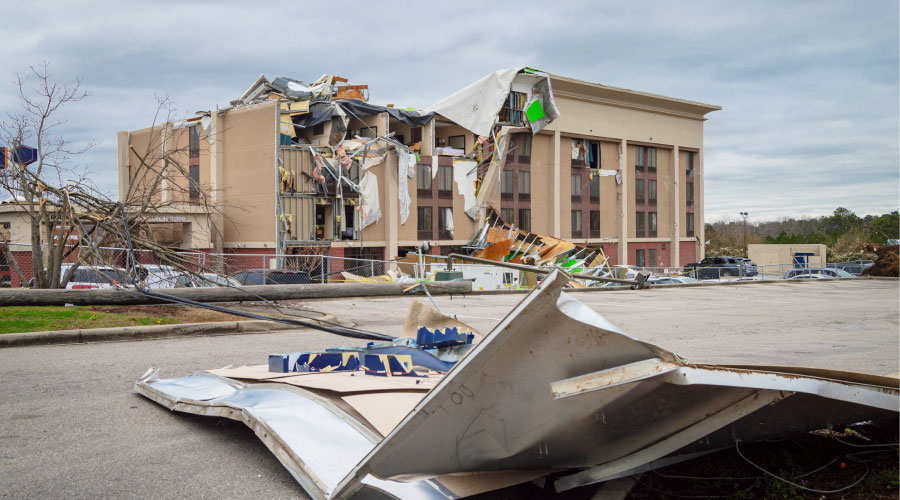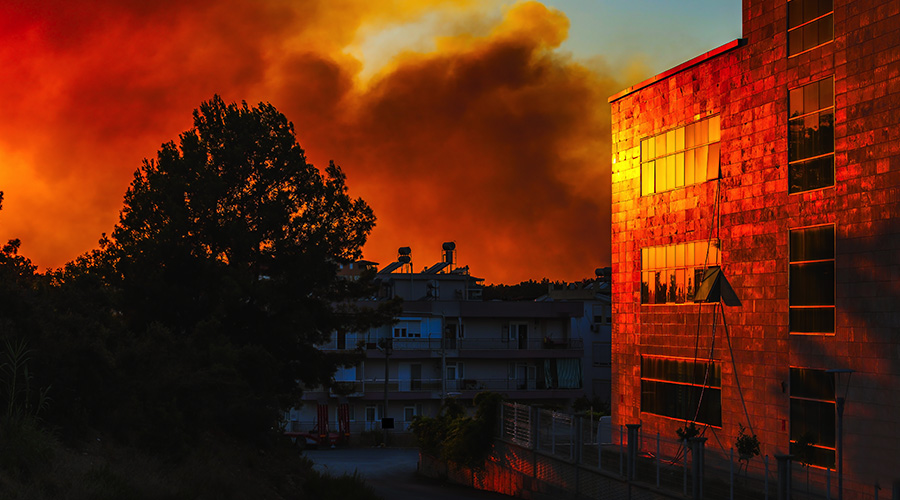An Emergency Planning Guide for Facilities
Planning for emergencies and disasters was once viewed as a necessary evil, something to keep the lawyers at bay. Sept. 11 changed that. Virginia Tech, Northern Illinois, Eastern Michigan, Central Arkansas and Columbine all changed that.
The truth is that a vast majority of facility executives will never need to respond to a large event like those attacks. But if a major event occurs, have you done what you can? Do you have a plan that works?
The task is enormous considering the range of threats that have to be identified and mitigated. For example, the U.S. Department of Homeland Security identifies the next threat to our nation (by 2013) as a biological or nuclear weapon of mass destruction. We cannot go back to the days when we dusted off the emergency plan once a year and updated contact information.
The first step is to use an “all hazards” risk matrix analysis to identify both hazards that are normal occurrences and those with a low probability for a specific facility. (See “How To Categorize Risk”) The next phase is to determine how critical each building is to the overall operation. Resources are then identified and allocated.
Here are eight critical issues and recommendations for developing emergency response plans.
1. Develop an emergency action plan, not a guidebook.
Not only should the emergency action plan identify all the hazards facing the facility, but it also should identify who does what and when. By employing the risk-matrix method of identifying hazards and allocating appropriate resources, the written plan now becomes an action document, updated when needed but with an appropriate timeframe to ensure accurate information, especially contact names and numbers.
2. Don’t plan to rely solely on first responders for immediate help.
The shootings at Virginia Tech and Northern Illinois were over before police could adequately respond. First responders, the local police or fire departments, may not even mobilize for one minute depending on how the original notification is given. Even on-campus public safety staff may not respond for a few minutes.
Creating an “immediate responder” network of crisis managers at each building or location is essential.
Identify a single point of contact for each building, then provide for additional assistance from others in those buildings to ensure that building occupants respond correctly, whether the process calls for evacuation or sheltering in place. Crisis managers should be trained in policies and procedures, first aid (including CPR and AED training), NIMS, and incident command and threat awareness/indicators. The latter is essential to ensure awareness of not only the threat, but what are the indicators and precursors to an incident.
All responding personnel — whether it’s the crisis managers who will provide the immediate response or first responders, often from the police or fire department — should be trained to support the emergency plan. The crux of the issue is whether immediate and first responders know what the other does and how they support each other’s efforts.
It is essential that crisis managers be aware of their responsibilities and be provided with adequate and continued training. Training is not just how to pull the fire alarm, give first-aid or use an AED. Training involves knowing what to do for the circumstance at hand and how to support first responders when they arrive. Consider establishing an in-house crisis manager certification program that encompasses these topics with incentives for continued training in the certification process.
All users of the action plan should know what to do and when. Most plans are never tested. When an alarm sounds, the reality is that most people assume that it’s another false alarm and go on with what they are doing.
3. Use Department of Homeland Security mandated NIMS courses.
The National Incident Management System (NIMS) was adopted after Sept. 11 as the de facto method of response by all government entities. NIMS affords everyone involved in crisis management and response the ability to understand the concepts and a set of processes and procedures that allow an orderly response to all incidents. It is designed for every situation from minimal participation to all area agency participation.
Recommended NIMS courses for all involved in emergency response are:
- IS-100a — Introduction to the Incident Command System
- IS-200a — ICS for Single Resources and Initial Action Incidents
- IS-700 — National Incident Management System, NIMS, An Introduction
- IS 800b — National Response Framework, An Introduction.
4. Establish tabletops, drills and exercises to support the training.
There is nothing worse that having a plan no one can understand or implement properly. Communications, regardless of the method, has historically been the biggest factor in the success of a plan, or in the case of miscommunications, its ultimate failure.
The plan should be tested by as many people as possible who have a role in an emergency — from crisis managers with their radios and colored vests to the executives who ultimately authorize evacuations of entire facilities.
Tabletops involve working in small groups to walk through an emergency scenario. All personnel responsible for a particular segment of the response plan have specific duties to perform and authorize others to perform. Tabletops can also be used to inject specific or general issues that change the normal response. As with any test, detailed documentation is needed to use as an after-action report, which serves as a means of review and change.
Drills involve setting up specific situations involving personnel to physically respond. The most common and simple is pulling the fire alarm to determine evacuation processes and participation. Of course, advance notice to the fire department is necessary, and they may even participate.
Exercises are similar to drills but encompass more detailed planning, more than one responding agency and a larger number of buildings and personnel. Many are scripted only in the area tested and not the outcome. The best exercises are the ones that require a lot of change to proscribed practices and a foundation of “no fault” in finding a better solution. “Hot washes” — an immediate walk through of what worked and what didn’t — occurs with the players and observers.
5. Establish a working relationship with first responders.
Contacts at fire, police, health department, hospitals and other emergency management agencies are critical for the proper response to a crisis. However, relying on the first responder agencies to show up with the proper number of personnel in the right location is far from reality when the only contact during the year is a phone call. Drills and exercises are designed not only to test emergency procedures, but to ensure contacts and communications are fully established. Take a chief to lunch; facility executives are often surprised as to what can be done to assist them with their responsibilities.
6. Create a perimeter group.
On a nice autumn day in 2005, a few hundred people suddenly occupied a courtyard of one of Georgia Tech’s dormitories. It turned out they were from the nearby Bellsouth Tower and had evacuated the building when the fire alarms sounded. What no one from Georgia Tech knew was that the school’s campus had been designated as Bellsouth’s “assembly point” in case of an evacuation. It turned out other companies in the area surrounding Georgia Tech also had assembly points on school property. On the face of it, that wasn’t a major issue, but if there were a major incident affecting the entire Georgia Tech/Downtown Atlanta area, there would be a lot of competition for evacuation assembly space.
This incident led to the creation of a Perimeter Group made up of all the companies and businesses surrounding Georgia Tech, including Bellsouth, Coca-Cola and Bank of America. The purpose of the group is to ensure everyone knows where they evacuate to and how. During an emergency, communications between the “groups” is considered vital to life safety.
7. Use technology.
At one time, emergency plans were pretty basic. They identified police and fire emergency numbers and internal numbers of critical personnel to assist those agencies. Call trees were used when only hard-wired telephones were in existence. Bull horns were often the technology of choice for evacuations.
Things have changed. Practically everyone has a cell phone, so a voice message or text can be sent to any person at any time. E-mail communications are the norm now and companies, agencies and schools all utilize this medium. Old siren systems only sounded a wail. Newer “voice over” siren systems allow a voice message after the siren sound. It affords the ability to direct different responses to different threats but still signifies a shelter in place result. Networks in businesses and universities can be used for notifications, phone systems (Voice Over Internet Protocol, or VOIP), IP intercoms, pop-up displays on computer screens, digital signage, and other methods of communication.
Deciding on which technologies to use is not easy. Developing a layered approach to communications and notifications is crucial to a flexible but operationally sound system.
8. Don’t rely on sales pitches.
Buying a product or signing up for a service that drives any life safety issue has critical consequences when it comes to performance. Most early notification systems tout the ability to send thousands of SMS texts, cell voice calls and e-mails within a short period of time. But does it take six to 10 minutes for a group of 50,000 subscribers to receive that message? Most incidents involving shooters are over in three to five minutes. It’s essential to ask specific questions to determine whether the product capabilities meet the demands of the facility.
For example, it’s worth finding out whether the system activates any other system, such as a siren system, digital signage or other communication device. Or is a series of converters needed between each system to enable them to communicate with one another other? Remember, any system that needs additional equipment to filter, funnel or converter to communicate with the main product is susceptible to failure. And avoid beta tests: Make sure that the product has a proven track record with other like-sized facilities.
Continue Reading: Emergency Planning Strategies
 An Emergency Planning Guide for Facilities
An Emergency Planning Guide for Facilities
 How to Categorize Risk
How to Categorize Risk
Related Topics:












